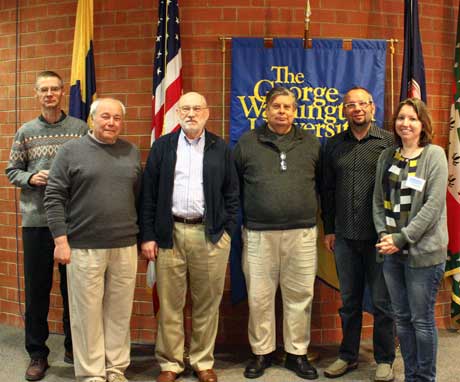GW professors Edward Teller and George Gamow, pioneers in nuclear physics, began a long and distinguished history for GW’s Department of Physics. Current faculty members continue in their footsteps with cutting-edge research and recent leadership in organizing the International Workshop on Partial Wave Analysis for Hadron Spectroscopy, held April 13-17, 2015 at GW’s Virginia Science & Technology Campus. The conference, organized by GW faculty members and their colleagues at Jefferson Lab and Indiana University, attracted more than 70 physicists from as far away as China and Australia.
“We were very excited to host this conference at GW and especially at our growing Virginia Science & Technology Campus,” said William J. Briscoe, professor and chair of the GW Department of Physics.
The organizing committee included Briscoe, Michael Doering (GW), Helmut Haberzettl (GW), Michael Pennington (Jefferson Lab) and Adam Szczepaniak (Indiana University/Jefferson Lab), as well as an international advisory committee of 24 distinguished researchers from around the world. The conference was organized as a follow-up event to two related professional conferences held in 2013 in Italy and Germany.
During the five-day conference experts from the experimental and theoretical physics community had the opportunity to hear from 50 presenters, all discussing niche topics in the field of hadron spectroscopy. The highly technical presentations included topics such as “Why are we still doing hadron spectroscopy?, “Exploratory calculations of meson resonances and bound states from lattice QCD” and “Identification of non-ordinary mesons from their Regge trajectories obtained from partial-wave poles.”
“The strong interaction is one of the fundamental forces of nature, like gravity, which is not yet well understood by physicists,” said Michael Doering, assistant professor of physics and conference organizer. “Understanding the behavior of hadrons has wide-ranging implications in the field of nuclear physics. Our GW-hosted conference brought together researchers from around the globe to share research and increase understanding in this area of nuclear physics.”
The workshop was divided into plenary sessions, topical presentations and several organized discussions, with the goal of sharing expertise from different analysis groups and experiments. During the discussions participants summarized state-of-the art research in hadron spectroscopy, highlighted unresolved questions and discussed the development of new tools for the next generation of experiments. The conference focused on partial wave analysis as a powerful tool for the discovery of hadrons and study of their masses and decays. For those interested in more details about the presentations, the abstracts and slides have been posted online.
“Particular to this conference, GW’s cutting-edge research in Hadron Spectroscopy, in collaboration with our colleagues at Jefferson Lab, Mainz, Juelich and Bonn, and our other collaborators around the globe, holds great promise for future discoveries,” said Briscoe.”


